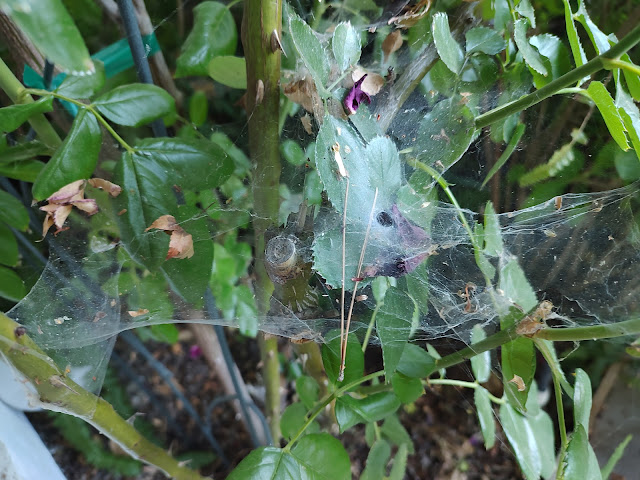
|
Spider mites' fine webs look very different from spider webs. Spider mites love dry, hot weather. (Photo: Debbie Arrington)
|
Noticing a lot of webs around your garden? Most likely, they’re not created by spiders – but spider mites.
An abundance of webs over shrubs, trees, tomatoes, light fixtures, outdoor furniture and more prompted some observers to jump to the conclusion that this summer was experiencing an explosion of spiders. (“Why are there so many spiders in Sacramento right now?” asked
The Sacramento Bee.
)
It’s normal for the big spiders (such as wolf) to come out in summer; this is their season. They hunt by casting web nets across garden spaces, then wait for winged insects to accidentally fly into their snares. Summer is when they’re most active – there’s a lot of winged insects to eat.
But the ubiquitous webs that seem to be covering all sorts of plants and outdoor surfaces right now were most likely spun by spider mites, tiny cousins of the more familiar arachnids.
Spider mites love hot, dry, dusty conditions with prolonged periods of no rain and low humidity. Sacramento right now is spider mite heaven.
So much dry heat has allowed spider mites to have a baby boom; they can produce a whole generation in five to 10 days. Each mama mite can lay 100 eggs.
Spider mites are so tiny – smaller than a pin prick – gardeners usually don’t notice them until they’re mature; that’s when they start spinning their telltale webs.
As they grow, they tend to hide out on the underside of foliage, practically invisible to even the most observant gardeners. Spider mite feeding may cause polka-dot stippling to appear on leaves.
According to the UC Cooperative Extension master gardeners, spider mites attack many fruit trees, shrubs, vines, berries, vegetables and other ornamental plants. Besides tomatoes and roses, they also love beans, grapevines, squash and melons.
The damage at first looks a little like peach leaf curl with foliage developing stipples and turning yellow or red before falling off. Then the webs start appearing, coating leaves and stems.
If left undisturbed, spider mites can overwhelm plants. They’re especially bad during drought conditions (like right now) and can do the most harm to water-stressed plants.
Spider mites can’t be controlled by insecticides – they’re not an insect, they’re a mite. But miticides are not recommended either; they kill many beneficial insects in addition to the mites, which often manage to evade pesticide sprays.
Neem oil applied in the early stages of an infestation may smother the mites, but also kills beneficial insects including those that eat mites. In addition, neem oil sprayed on hot days can cook the plant’s foliage – eliminating any benefit.
The best way to treat spider mites: A cold hard shower. Grab a hose and make it “rain.” Washing down foliage mimics a summer storm and disrupts the mites’ happy homes.
Insecticidal soap also can be helpful if applied at the first signs of trouble. Make sure to spray the underside of leaves, too.
For more advice, see the UC IPM pest notes on spider mites:
http://ipm.ucanr.edu/PMG/PESTNOTES/pn7405.html

